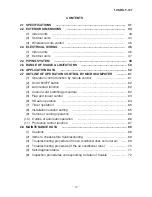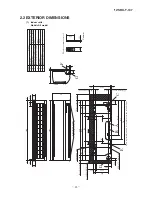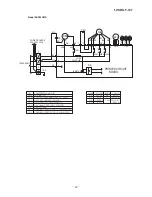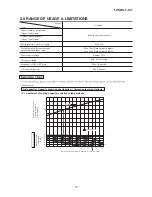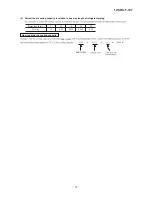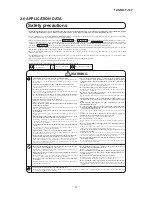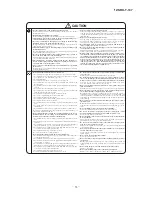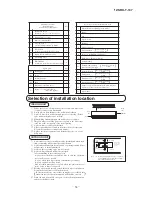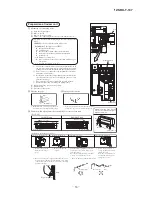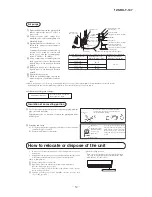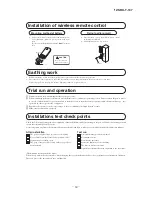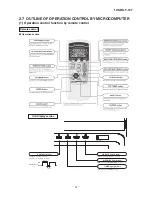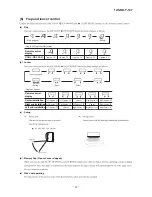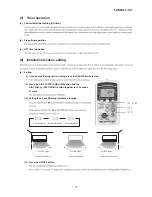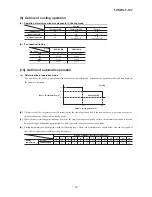
-
-
'12•SRK-T-137
CAUTION
v
Use the circuit breaker with sufficient breaking capacity.
If the breaker does not have sufficient breaking capacity, it can cause the unit
malfunction and fire.
v
Earth leakage breaker must be installed.
If the earth leakage breaker is not installed, it can cause electric shocks.
v
Install isolator or disconnect switch on the power supply wiring in ac-
cordance with the local codes and regulations.
v
Be sure to install indoor unit properly according to the instruction
manual in order to run off the drainage smoothly.
Improper installation of indoor unit can cause dropping water into the room
and damaging personal property.
v
Install the drainage pipe to run off drainage securely according to the
installation manual.
Incorrect installation of the drainage pipe can cause dropping water into the
room and damaging personal property.
v
Be sure to install the drainage pipe with descending slope of 1/100 or
more, and not to make traps and air-bleedings.
Check if the drainage runs off securely during commissioning and ensure the
space for inspection and maintenance.
v
After maintenance, all wiring, wiring ties and the like, should be re-
turned to their original state and wiring route, and the necessary clear-
ance from all metal parts should be secured.
v
Secure a space for installation, inspection and maintenance specified in
the manual.
Insufficient space can result in accident such as personal injury due to falling
from the installation place.
v
Take care when carrying the unit by hand.
If the unit weights more than 20kg, it must be carried by two or more per-
sons. Do not carry by the plastic straps, always use the carry handle when
carrying the unit by hand. Use gloves to minimize the risk of cuts by the
aluminum fins.
v
Dispose of any packing materials correctly.
Any remaining packing materials can cause personal injury as it contains
nails and wood. And to avoid danger of suffocation, be sure to keep the plas-
tic wrapper away from children and to dispose after tear it up.
v
For installation work, be careful not to get injured with the heat ex-
changer, piping flare portion or screws etc.
v
Be sure to insulate the refrigerant pipes so as not to condense the ambi-
ent air moisture on them.
Insufficient insulation can cause condensation, which can lead to moisture
damage on the ceiling, floor, furniture and any other valuables.
v
When perform the air conditioner operation (cooling or drying opera-
tion) in which ventilator is installed in the room. In this case, using the
air conditioner in parallel with the ventilator, there is the possibility that
drain water may backflow in accordance with the room lapse into the
negative pressure status. Therefore, set up the opening port such as in-
corporate the air into the room that may appropriate to ventilation (For
example; Open the door a little). In addition, just as above, so set up the
opening port if the room lapse into negative pressure status due to regis-
ter of the wind for the high rise apartment etc.
v
Do not install the unit in the locations listed below.
v
Locations where carbon fiber, metal powder or any powder is floating.
v
Locations where any substances that can affect the unit such as sulphide
gas, chloride gas, acid and alkaline can occur.
v
Vehicles and ships.
v
Locations where cosmetic or special sprays are often used.
v
Locations with direct exposure of oil mist and steam such as kitchen and
machine plant.
v
Locations where any machines which generate high frequency harmonics
are used.
v
Locations with salty atmospheres such as coastlines.
v
Locations with heavy snow (If installed, be sure to provide base flame and
snow hood mentioned in the manual).
v
Locations where the unit is exposed to chimney smoke.
v
Locations at high altitude (more than 1000m high).
v
Locations with ammonic atmospheres.
v
Locations where heat radiation from other heat source can affect the unit.
v
Locations without good air circulation.
v
Locations with any obstacles which can prevent inlet and outlet air of the
unit.
v
Locations where short circuit of air can occur (in case of multiple units
installation).
v
Locations where strong air blows against the air outlet of outdoor unit.
It can cause remarkable decrease in performance, corrosion and damage of
components, malfunction and fire.
v
Do not install the indoor unit in the locations listed below (Be sure to
install the indoor unit according to the installation manual for each
model because each indoor unit has each limitation).
v
Locations with any obstacles which can prevent inlet and outlet air of the
unit.
v
Locations where vibration can be amplified due to insufficient strength of
structure.
v
Locations where the infrared receiver is exposed to the direct sunlight or
the strong light beam (in case of the infrared specification unit).
v
Locations where an equipment affected by high harmonics is placed (TV
set or radio receiver is placed within 1m).
v
Locations where drainage cannot run off safely.
It can affect performance or function and etc.
v
Do not install the outdoor unit in the locations listed below.
v
Locations where discharged hot air or operating sound of the outdoor unit
can bother neighborhood.
v
Locations where outlet air of the outdoor unit blows directly to plants.
v
Locations where vibration can be amplified and transmitted due to insuffi-
cient strength of structure.
v
Locations where vibration and operation sound generated by the outdoor
unit can affect seriously (on the wall or at the place near bed room).
v
Locations where an equipment affected by high harmonics is placed (TV
set or radio receiver is placed within 1m).
v
Locations where drainage cannot run off safely.
It can affect surrounding environment and cause a claim.
v
Do not install the unit near the location where leakage of combustible
gases can occur.
If leaked gases accumulate around the unit, it can cause fire.
v
Do not install the unit where corrosive gas (such as sulfurous acid gas
etc.) or combustible gas (such as thinner and petroleum gases) can accu-
mulate or collect, or where volatile combustible substances are handled.
Corrosive gas can cause corrosion of heat exchanger, breakage of plastic
parts and etc. And combustible gas can cause fire.
v
Do not use the indoor unit at the place where water splashes may occur
such as in laundries.
Since the indoor unit is not waterproof, it can cause electric shocks and fire.
v
Do not install nor use the system close to the equipment that generates
electromagnetic fields or high frequency harmonics.
Equipment such as inverters, standby generators, medical high frequency
equipments and telecommunication equipments can affect the system, and
cause malfunctions and breakdowns. The system can also affect medical
equipment and telecommunication equipment, and obstruct its function or
cause jamming.
v
Do not place any variables which will be damaged by getting wet under
the indoor unit.
When the relative humidity is higher than 80% or drainage pipe is clogged,
condensation or drainage water can drop and it can cause the damage of valu-
ables.
v
Do not install the remote control at the direct sunlight.
It can cause malfunction or deformation of the remote control.
v
Do not use the unit for special purposes such as storing foods, cooling
precision instruments and preservation of animals, plants or art.
It can cause the damage of the items.
v
Do not install the outdoor unit in a location where insects and small ani-
mals can inhabit.
Insects and small animals can enter the electric parts and cause damage or
fire. Instruct the user to keep the surroundings clean.
v
Do not use the base flame for outdoor unit which is corroded or dam-
aged due to long periods of operation.
Using an old and damage base flame can cause the unit falling down and
cause personal injury.
v
Do not use any materials other than a fuse with the correct rating in the
location where fuses are to be used.
Connecting the circuit with copper wire or other metal thread can cause unit
failure and fire.
v
Do not touch any buttons with wet hands.
It can cause electric shocks.
v
Do not touch any refrigerant pipes with your hands when the system is
in operation.
During operation the refrigerant pipes become extremely hot or extremely
cold depending the operating condition, and it can cause burn injury or frost
injury.
v
Do not touch the suction or aluminum fin on the outdoor unit.
This may cause injury.
v
Do not put anything on the outdoor unit and operating unit.
This may cause damage the objects or injury due to falling to the object.
Summary of Contents for SRK-13CMS-2
Page 46: ... 45 12 SRK T 137 3 Wireless remote control Unit mm 60 17 3 150 Unit mm 60 17 3 150 ...
Page 71: ... 70 12 SRK T 137 4 Troubleshooting procedure If the air conditioner runs NO YES 71 ...
Page 79: ... 78 12 SRK T 137 ...
Page 108: ... 107 12 SRK T 137 MEMO ...
Page 114: ... 113 12 SRK T 137 MEMO ...
Page 117: ... 116 12 SRK T 137 CRBE0290 6 11 9 10 13 14 3 15 12 2 4 8 7 5 1 7 7 PANEL FAN ASSY ...
Page 121: ... 120 12 SRK T 137 CRBE0290 6 11 9 10 13 14 3 15 12 2 4 8 7 5 1 7 7 PANEL FAN ASSY ...
Page 125: ... 124 12 SRK T 137 CRBE0290 6 11 9 10 13 14 3 15 12 2 4 8 7 5 1 7 7 PANEL FAN ASSY ...
Page 129: ... 128 12 SRK T 137 CRBE0290 6 11 9 10 13 14 3 15 12 2 4 8 7 5 1 7 7 PANEL FAN ASSY ...
Page 133: ... 132 12 SRK T 137 CRBE0290 6 11 9 10 13 14 3 15 12 2 4 8 7 5 1 7 7 PANEL FAN ASSY ...
Page 137: ... 136 12 SRK T 137 CRBE0290 6 11 9 10 13 14 3 15 12 2 4 8 7 5 1 7 7 PANEL FAN ASSY ...
Page 141: ... 140 12 SRK T 137 CRBE0221 12 16 17 1 2 3 5 6 7 8 9 10 13 16 14 15 4 11 PANEL FAN ASSY ...

